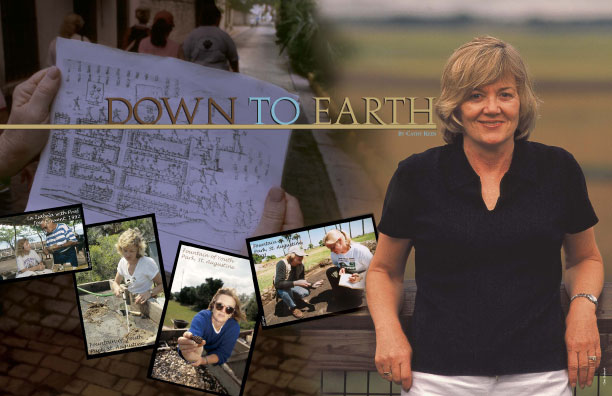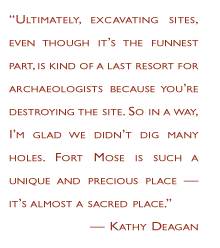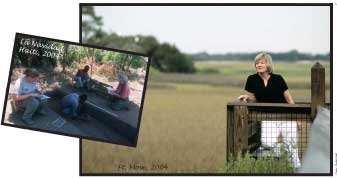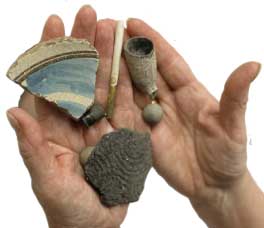|
|

Acclaimed UF Archaeologist Kathy Deagan Resurrects Societies Long Lost to HistoryBy Cathy Keen Kathy Deagan's childhood memories include being chased through the streets of Taiwan by local boys trying to pull her exotic-looking blonde hair. Experiences like that were common for the University of Florida archaeologist as her family traveled the world, following her Navy meteorologist father to places like Guam and the Philippines where he studied tropical storms. Deagan maintains that being the new kid on the block - at least 22 moves through high school by her count - fostered an early interest in different cultures and social organizations that proved invaluable in her pursuit of centuries-old mysteries about the European settlement of the Americas. "It was always hard the first or second week of school deciding whom to sit next to in the cafeteria," says Deagan of adjusting to her constantly changing schools. "I wonder if the constant newness made me more interested in cultural differences."
The earliest European settlement in the New World. The oldest symbol of Christianity found in the Western Hemisphere. The first refuge for free blacks in what is now the United States. To these exciting discoveries, Deagan recently added an impressive accolade: the 2004 J.C. Harrington Medal from the Society for Historical Archaeology. The award is presented for a lifetime of contributions to the discipline. "This award typically goes to people who are close to retiring or have recently retired," says Bonnie McEwan, one of Deagan's former students and now archaeology director at the Mission San Luis in Tallahassee, who nominated the 57-year-old Distinguished Research Curator for the award. "But I honestly couldn't think of anyone in the field of archaeology who had accomplished more than Kathy at any age. A lot of people commented that Kathy getting the award raised the bar of who would be eligible." The close-knit camaraderie of shared fieldwork and laboratory experiences first drew Deagan to archaeology. But as one who loves crossword puzzles, it is the challenge of unraveling clues to old mysteries that keeps her fresh. "In many areas, archaeology contains the only available information about the past and about certain cultures," she says. "Certainly for Native Americans, who have no written history, and for everyone else, there are a lot of aspects of who we are and how we got to be who we are - some of these daily life questions - that can be answered only by looking at fragments from the material world." The project she is most proud of in her distinguished career is Fort Mose, where runaway slaves established the first legally sanctioned black town in North America. Fort Mose's story of freedom won even while slavery existed is now incorporated into fourth-grade social studies textbooks thanks to her groundbreaking work on the small marshy island just north of St. Augustine, and more than 7 million Americans have seen the traveling exhibit she and her team created.
"It really has shifted the view of the
American past, which for us has been more important than
pot shards or dirt stains or just the archaeological aspects
of the site," she says. Jane Landers, a former Deagan graduate student who is now a history professor and associate dean at Vanderbilt University, says Deagan handled the criticism tactfully. "She didn't back down to anybody and she wasn't confrontational, but she was sure of her scholarship and rested on it," Landers says. Although she has been a trailblazer for women in her field, Deagan is reluctant to attribute any past career difficulties to gender, her students agree. While a graduate student at UF, though, Deagan and her mentor, the late anthropology professor Charles Fairbanks, initiated a discrimination lawsuit against the state of South Carolina. Deagan wanted to work on a bicentennial project excavating a fort but was told that women were hired only for the lab. "They gave all sorts of reasons why women couldn't work in the field - we can't drive piles into mud, we can't tear down the engine of a steamroller and they'd have to dig a separate latrine," she says. The American Civil Liberties Union took up the case and Deagan's application was finally accepted, although by then she had taken another job. Fairbanks, a former chair of the UF anthropology
department, was a major influence on Deagan. He was one
of the founders of "He had been working on the idea of the archaeology of slavery, which no one had ever done before," Deagan says. "It was intriguing to learn that for slaves, or any group of people who didn't write, no matter how many historical documents you read, you really didn't know what was going on." Fairbanks advocated a shift from monumental structures to backyard archaeology, and under his stewardship Deagan excavated the 18th-century St. Augustine household of an Indian woman and her Spanish soldier husband to see what mix of customs was reflected in food preparation techniques, crafts and other household activities that illustrate the texture of their lives. Deagan's work continues to reflect her fascination with race, ethnicity and gender, and she encourages her students to examine little-studied social aspects. One recent graduate student wrote her dissertation on the role of children in the archaeological record, examining artifacts that Deagan had unearthed in St. Augustine. "We usually talk about economy and occupation and income, but it's becoming increasingly evident that even children had an impact on shaping the material world," Deagan says. "They tell us about the values and conditions that every single person had to go through to be a grownup." Deagan was never able to incorporate children into her own life, filled with so many excavations in the Caribbean and St. Augustine, but in mid-life she married wildlife ecologist Larry Harris, who has an international reputation of his own, and became stepmother to his four children, some of whom accompanied her on archaeological digs as they grew older. "I spent probably 25 years being in the field at least six months of the year, and no one with small children could do that," she says. Working side by side in the field builds strong student-teacher relationships, Deagan says. "You can't be this remote figure in front of the classroom or even a friendly figure in front of the classroom because you're cooking and eating together," she says. Known for her engaging, approachable manner, Deagan commands respect from her students without having to demand it. "Here she was, this small young woman running a class," says Charles Ewen, an anthropology professor at East Carolina University who received his Ph.D. from UF in 1987. "Many of her students weren't that much younger, and yet there was never any question as to who was in charge. She exuded an air of authority." Although she expects hard work from her students - essays are routinely returned with a flood of red ink - she rewards them afterward with some kind of party. One wacky event that became an annual tradition involved students in St. Augustine holding an end-of-dig "prom" wearing formal attire from local thrift shops. Students on Caribbean projects celebrated in other ways, once inviting a National Geographic crew filming Deagan's work in Haiti to attend a voodoo festival, says Jim Cusick, a former student who is now a curator in the special collections department at UF's Smathers Library. Over the years, Deagan led a series of excavations at En Bas Saline in Haiti, where she found what is believed to be the vanished colony of La Navidad. There, Columbus built a fort from the timbers of his ship the Santa Maria, which crashed into a reef on Christmas Eve 1492. Her discovery of a jaw from a European rat and a tooth from a pig, animals unknown in the Americas before Columbus, were among the strongest evidence. But Haiti's military unrest following the overthrow of the government in the mid 1980s made it difficult for Deagan to continue her work, even though she kept her cool during those turbulent times. Once, when the roads to the site were too
dangerous to travel, Deagan called off work at the dig and
holed up with her students at a local hotel. While Cusick
paced, Deagan sat on the veranda reading a paperback novel. Deagan's lightheartedness off the field is balanced by earnestness in following rigorous excavation methods on it. When a Discovery Channel film crew documented her search for the fort at La Navidad for a special that aired last spring, they kept pressuring her to say on camera that she had found the lost colony. But Deagan stubbornly resisted, insisting they must first find a trench with charcoal marks to confirm a fire described in historical documents. Much to her amazement, they found the trench
that same day, which also happened to be during the last
week of the dig. Recognizing exciting projects, such as Columbus' first settlement, is one key to Deagan's success, says Darcie MacMahon, assistant director in charge of exhibits at the Florida Museum of Natural History on the UF campus, who worked with Deagan on the Fort Mose traveling exhibit and co-wrote a book about the project. "She picks high-profile sites, but really the questions she tries to answer are much broader than 'Is this the first site?'" MacMahon says. "Her objective is to understand how history happens, how people lived in the past and what the interaction between cultures is like." That approach has influenced her students, many of whom are making their own contributions to the field. Landers has her history students at Vanderbilt read historical archaeology, much of it Deagan's work, in addition to primary documents because indigenous people and those of African descent often are not reflected in written records. "It really changed the way I train my students, to have that background in historical archaeology and to be so attuned to the material culture," Landers says. Deagan was an important role model for Landers. "I saw how she moved through different parts of the professional world, from being in mud and muck in the field, to being in a suit and conducting a press conference, to dealing with all of her graduate students in such an encouraging yet demanding way," she says. The research Landers did for Deagan as a graduate student in the archives of Seville, Spain, where she found census documents containing the names of slaves who years later were to establish Fort Mose, launched Landers' career in ways she never anticipated. Shortly after earning her doctorate, she published a paper about the subject in a leading American history journal and later wrote Black Society in Spanish Florida, recognized as the year's best first book in Southern history by the Southern Historical Association. The discovery of Fort Mose received international acclaim when it was announced in a front-page story in The New York Times. But excavations were halted a short time later at the fragile site located atop a pile of old shells. "Ultimately, excavating sites, even though it's the funnest part, is kind of a last resort for archaeologists because you're destroying the site," Deagan says. "So in a way, I'm glad we didn't dig many holes. Fort Mose is such a unique and precious place - it's almost a sacred place." Fort Mose's stature may have played a role in the National Endowment for the Humanities' decision to select St. Augustine as the site for a news conference announcing its new program "Landmarks of American History,'" a series of seminars for school teachers around the country. Deagan and former students Landers and Cusick were among the experts teaching the seminar at Flagler College in St. Augustine last summer. Deagan gave the group a presentation about Fort Mose and then led a tour of St. Augustine, pointing out some of the sites she had excavated or interpreted over the years. Frequently, she was interrupted by greetings from local residents stopping to say hello. "The entire town of St. Augustine knows her," MacMahon says. "She worked there for so many years, digging in people's backyards. She brought the history of their town to life." Indeed, the girl who never spent more than a few months in any one place during her childhood has spent her career helping St. Augustine and other places find their roots. Kathleen Deagan Related Web sites: |
 Those
early experiences may explain Deagan's ease in relating
to all kinds of people, from villagers and landowners to
legislators and scientists. That, along with grit, a keen
intellect and a special brilliance in interpreting the past,
propelled her to the top of the field of historical archaeology
by her early thirties.
Those
early experiences may explain Deagan's ease in relating
to all kinds of people, from villagers and landowners to
legislators and scientists. That, along with grit, a keen
intellect and a special brilliance in interpreting the past,
propelled her to the top of the field of historical archaeology
by her early thirties.

 historical
archaeology, which incorporates written documents as well
as artifacts from archaeological sites. It was established
as a formal discipline only in 1968, six years before Deagan
earned her doctoral degree.
historical
archaeology, which incorporates written documents as well
as artifacts from archaeological sites. It was established
as a formal discipline only in 1968, six years before Deagan
earned her doctoral degree.